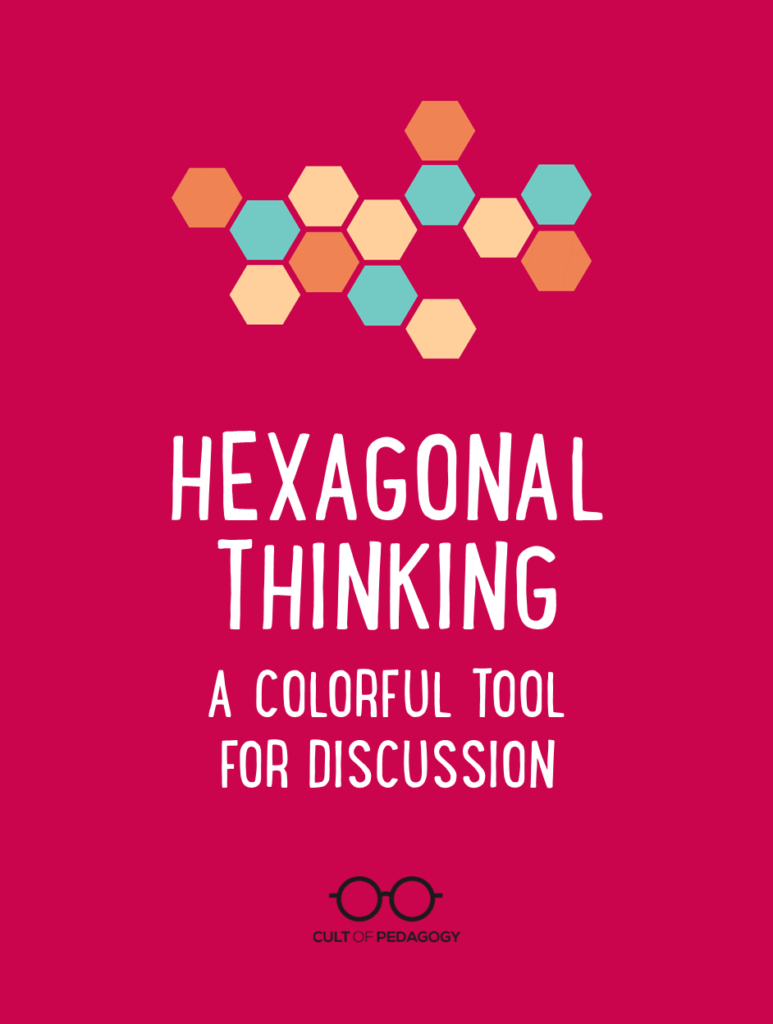
Listen to the interview with Betsy Potash:
Sponsored by Teaching Channel and UL Xplorlabs
While hexagonal thinking is not new in the world of business and innovation, it’s just making its way into the classroom. It’s a method for considering the connections between ideas and finding the nuances in those connections. If you’re looking for a fresh framework for discussion and critical thinking, this may be just the thing.
How it Works
When you place an idea on a hexagon, it has six sides where connections could be made to other ideas. When you place many ideas on many hexagons, the discussion about where to connect what will be different every time.
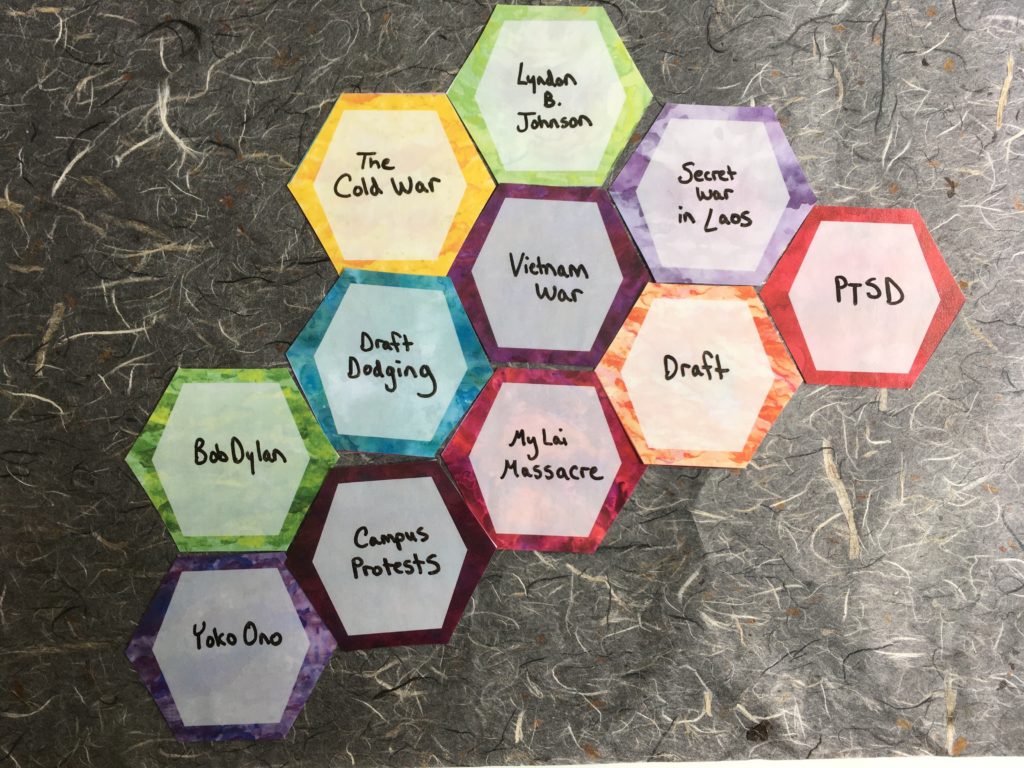
(click all images for a close-up view)
If you gave the same seven idea cards to seven people, do you think you’d get the same seven webs of interconnected hexagons? Would the people explain the connections in the same way?
Nope.
And really, that’s the beauty of hexagonal thinking. It provides a springboard for a totally creative discussion. When you give a small group of students a deck of hexagons and ask them to connect them however they choose, every group will come up with a different web for different reasons. Along the way they’ll hopefully question each other and dig deep into the concepts on the cards, arguing about which idea connects more to an important concept and which example deserves one of those precious six sides.
The Step-by-Step
Let’s imagine you’ve got your students in small groups, and each group is staring at a beautiful deck of hexagons.
Now what?
I recommend you kick off this activity for the first time by giving directions something like this:
Once you have your set of hexagons, it’s time for your group to begin making connections between them. Your conversations now will be about showing how and why you think the different ideas and options connect. Everyone will see things differently, and that’s OK. Just keep talking until you find the connections that stick. As you discuss your ideas, use the text to find supporting evidence for why you think your connections are strong ones.
Each hexagon can connect to up to six others. Arrange and rearrange until you feel you have the strongest hexagon web in place that you can. Then begin explaining your connections with connection arrows, writing in why you have created intersections between key hexagons.
Everyone in the group will contribute differently, and that’s OK. You need to have people listening and moving pieces to create the web, people debating, people asking questions.
By the end of your discussion, you should have an interconnected web of concepts along with clearly explained connections. If you’re working with paper hexagons, tape or glue them down to another sheet of paper to secure them, or take a photo of your finished web. If you’re working digitally, submit your two slides: the finished hexagon web, followed by the slide with your explanations.
There’s a lot of room here for students to participate in their own unique ways. For me, part of the point of the activity is for students to see that everyone can take on different roles that matter.
Two Examples
Let’s take a look at what this might look like in your classroom. In this case, I’ll share digital examples created in Google Slides, since you may well be leading your discussions and small group activities via online channels this year. But paper hexagons are equally wonderful when you can use them.
Example 1: English Language Arts
First let’s take a look at a hexagonal thinking discussion for an English class, wrapping up a unit on 1984.
Here’s the set-up, with the terms listed in individual (moveable) text boxes.
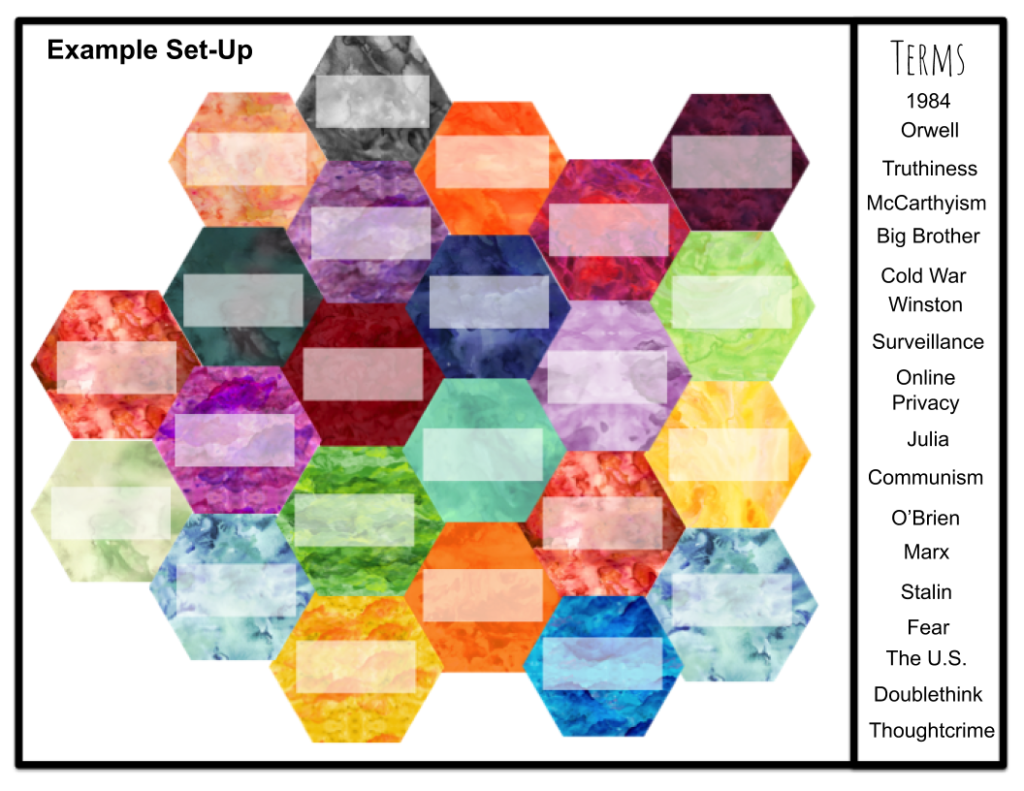
Now students can discuss the placement of their terms/hexagons. In this case, rather than shifting paper hexagons around, they will go into the Google Slide, then drag and drop their terms across the slide and into the web of hexagons as they decide where to place them.
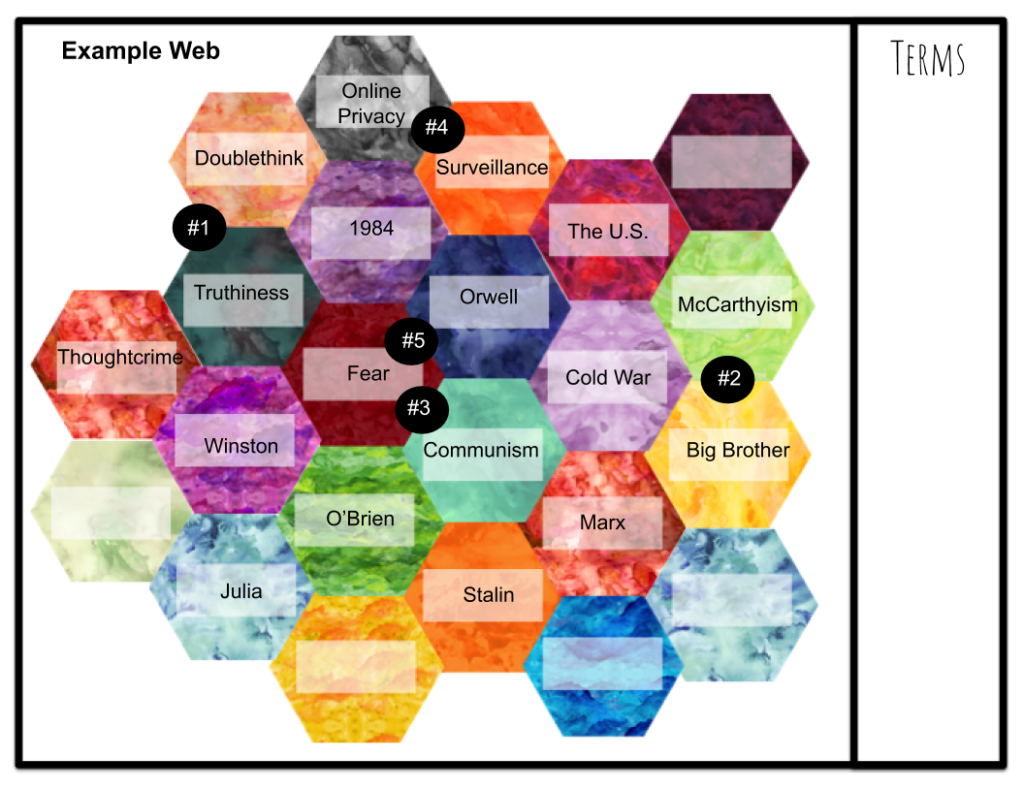
Now that the students have made their connections as they wish, they need to explain their choices. This can take place in many ways:
- Students could record arguments for one or two connections on a tool like Flipgrid,
- Students could write down their analysis.
- Groups could collaborate to write explanations for several of their connections or present them back to the class.
Take a peek at what the written explanations look like for the web pictured above. In this case, students are sharing five explanations, but you could adjust that to suit your needs. Some connections are always going to be more interesting than others – the ones that generate the most debate, the surprising ones, the ones where three key sections link in one place. Have students write or present about the key connections, rather than about every single one.
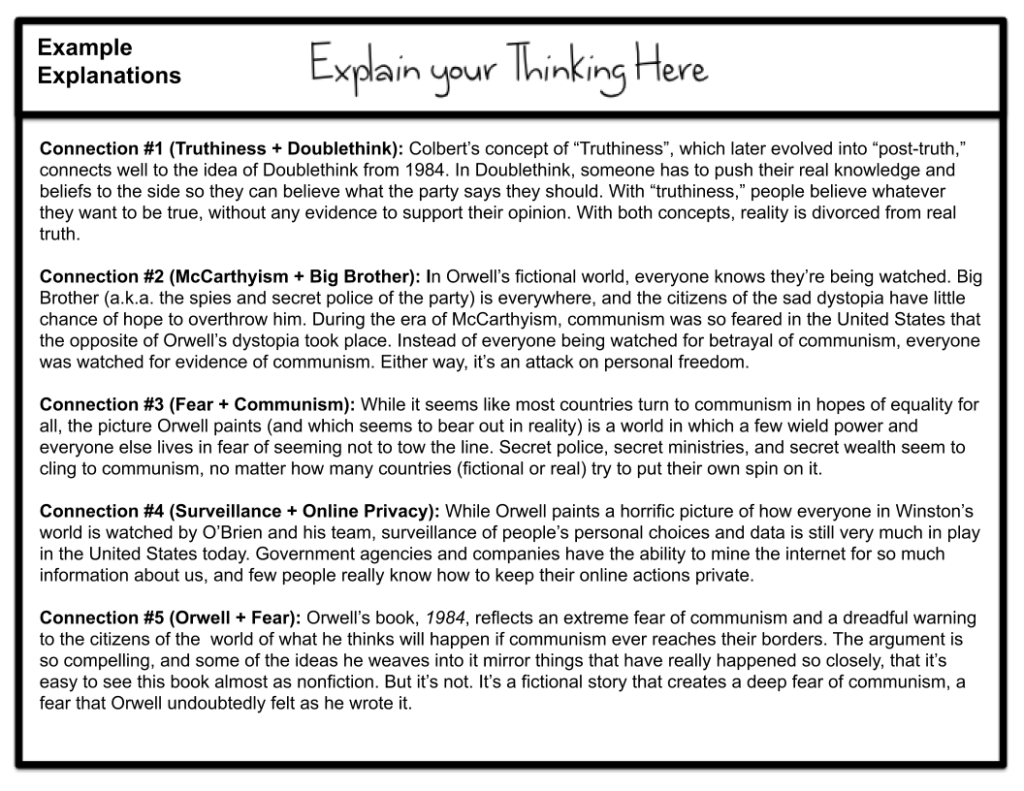
Example 2: Science
Now let’s take a look at how this might look in a science class. Imagine you’re looking back over a unit on global warming, and helping students review the big ideas.
Here’s the set-up: For this version, students can move the hexagons as well as the terms, creating any number of different webs. Then they use the connection arrows to point to the intersections they are going to explain in detail.
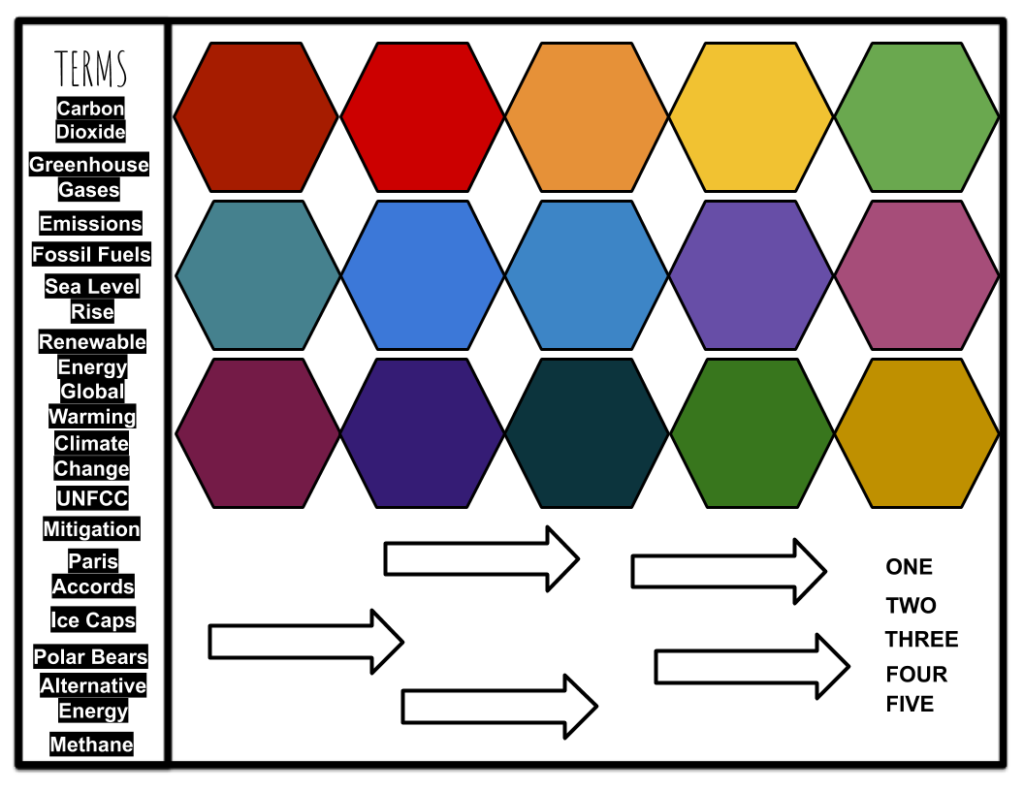
Student groups discuss the possibilities, dragging the hexagons and terms into place as they go. The final product could look one hundred different ways.
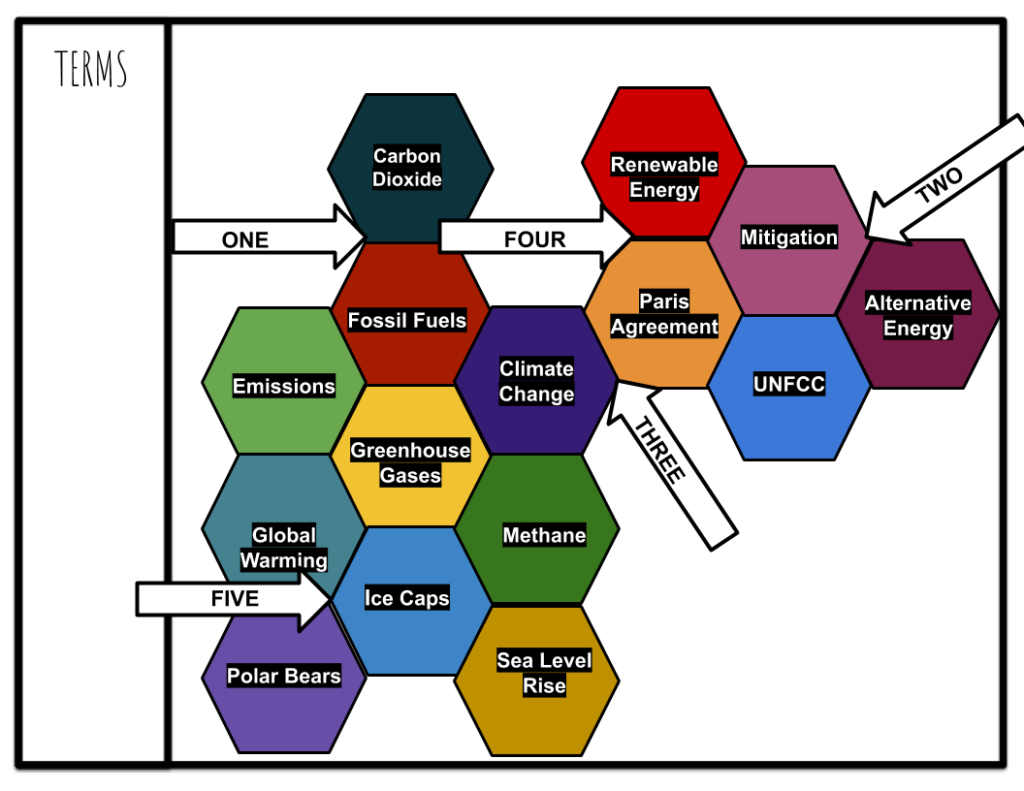
Once they have their web created, they make their explanations.
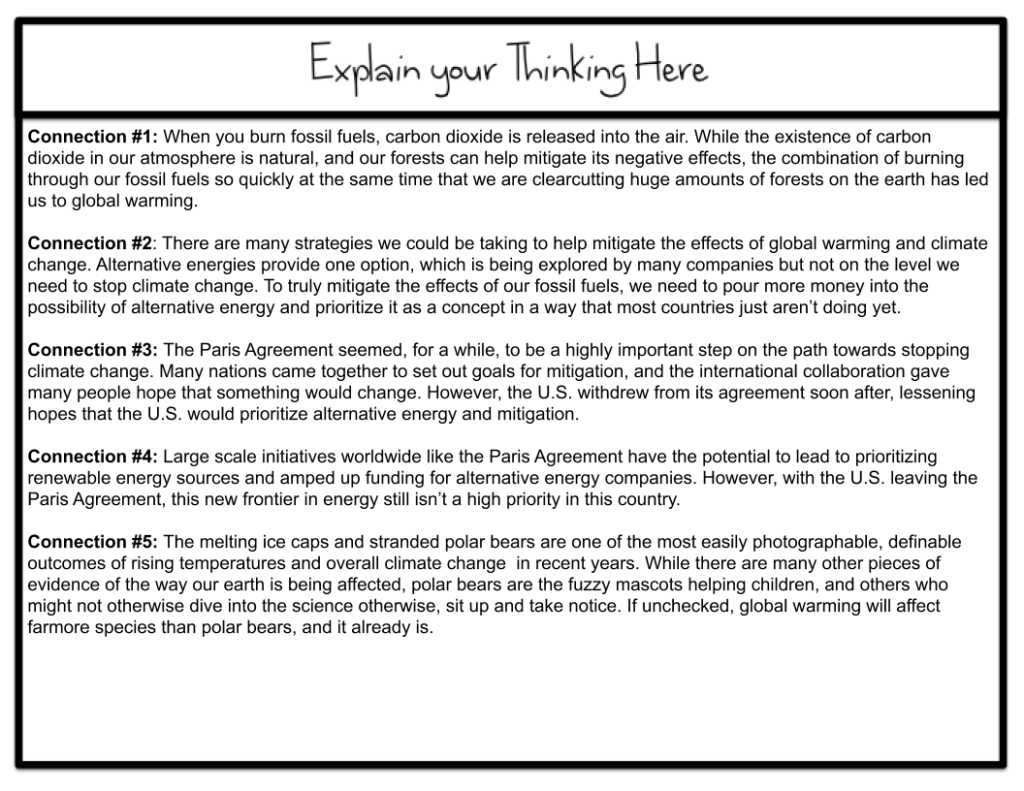
Creating Your Hexagonal Thinking Decks
You can create decks of hexagons with the terms already inside (let your students help you cut them out!) or print blank hexagon sheets and invite student groups to brainstorm the concepts to put inside before their discussion.
No matter how you create them, you want the hexagon decks to be filled with the key ideas of your recent class work, as well as interesting ties across disciplines and to the modern world. Hexagonal thinking makes it easy to cross disciplines and bring relevant modern connections into the discussion.
- Let’s say you’re creating a hexagon deck for Jason Reynolds’ book, Long Way Down. You’ll fill it with characters, themes and style elements, but also with figures from the news, current political movements, similar books, and background information about the author.
- Now imagine you’re creating a deck for a unit covering an artistic period. You can put in key terms and artists, but also important authors and political figures of the period, and artists and movements of today that connect back.
As for making the shapes themselves, there are lots of time-saving options, whether you want to use digital hexagons or paper ones.
Digital Hexagons
- Get access to your free copy of the digital hexagonal thinking toolkit featured above right here.
- Create your own digital hexagons with PowerPoint or Google Slides by following these instructions:
Paper Hexagons
- Use this online hexagon generator, created by Pam Hook.
- Print and laminate these free rainbow hexagons, then add concepts with dry erase markers for quick discussions.
- Print blank sheets of hexagons (you can easily create these in any size using the shapes tool in PowerPoint) to give out to small groups of students, then ask them to generate key terms, ideas, connections to other disciplines, connections to the modern world, etc. on their hexagons and cut them out. Then have groups switch decks so they are discussing a fresh list of ideas.
- Create your own hexagon templates with terms you can change up whenever you want to do a hexagonal thinking discussion. Cut them out while watching New Girl on Netflix, or make the first step of the discussion in class to cut out the hexagons while beginning to discuss how they will connect.
A fun addition to any paper deck is a set of connection arrows. Print a few bubble arrows (again, the PowerPoint shapes tool makes it easy) on paper for students to put in at key intersections. Have students fill them in with their explanation of the connection. Sticky notes will also work well.
Wondering how to grade this?
There are a few ways you could grade hexagonal thinking. You could have everyone write a short reflection at the end about their contributions, and grade that. You could use it as a springboard into a writing assignment, asking students to explain and argue for key connections from the discussion, then grade that. You could have students present about a key connection on Flipgrid. Easy.
But I want to suggest a slightly more complex option too. Recently I interviewed Sarah Fine, co-author of In Search of Deeper Learning. One of her findings, after years of study across American high schools, was that we rarely ask students to truly collaborate in our core subjects, so we don’t really create a culture of interdependence among them. They don’t get to use their individual gifts to contribute to a final product created by the team, although that is often what real-world projects look like. Instead, we favor what she calls “lockstep learning.” Everyone must do the same thing, separately.
So maybe for hexagonal thinking, you grade the final group web. And you ask the kids to share about how their different strengths allowed them to contribute to the final product.
Maybe some kids are super brainstormers, coming up with lots of great terms and ideas for what to put on the hexagons. Maybe one or two students in the group are great at lettering and drawing. They could create beautiful visual representations of the terms and ideas. Maybe some students shine at leading discussion. Maybe some are natural at making spatial and visual connections, and can help move the hexagons around as they listen to the group. Maybe some are excellent listeners, and can be taking notes about the connections based on what they hear from others. Maybe some are good mediators, who can help find common ground and calm down heated debates when discussion gets intense.
If you go this route, I really think it’s worth discussing in advance what project teams are like in the workplace, and how people contribute in different ways. Then, at the end, you might let kids write a short paragraph about how they contributed based on their own strengths and skills, and whether they were happy with the way the group dynamics turned out.
Variations and Additions
Individuals or Partners
This would certainly work as an individual assignment or a prompt for partners as well. But with a small group, you’ll get more perspectives on where to place what, which can be nice. You might consider giving students the option to work alone, with a partner, or in a group.
Adding Visuals
If you and your students are fans of sketchnotes or one-pagers, you can always add a visual layer to your hexagons. Invite students to illustrate their concepts with representative imagery and add quotations from their texts to bring more meaning for each idea into the conversation.
This is certainly not necessary, but adds dimension to the discussion and the eventual display of the concept web.
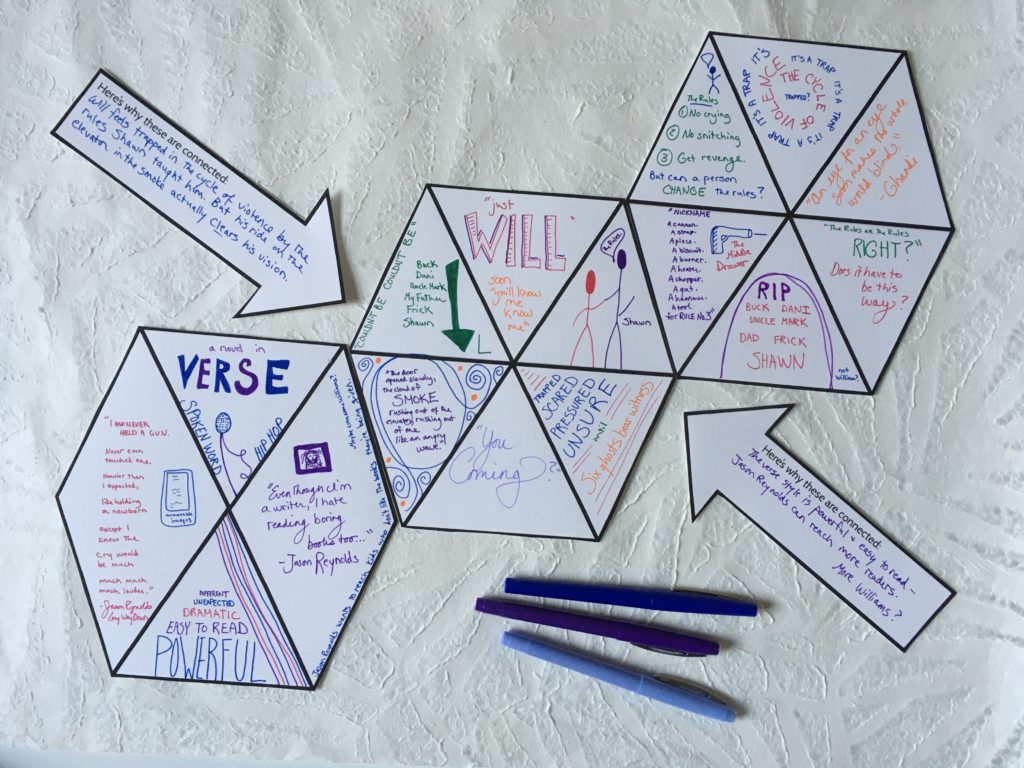
Gallery Walking
Once your students have completed their webs, you can do a gallery walk to see each other’s concept webs and check out the connections their peers have made (this can be done online through a collaborative Google slides presentation), or have each group in turn present briefly back to the class about some of their most interesting connection points. The hexagons that caused the most debate will probably be the most fun to share back, and everyone will get to see how others mixed and matched the same hexagons in unique ways.
When you bring hexagonal thinking into your classroom—whether that’s online or in person—you bring a fresh spark of energy to discussion. Your students will see things in new ways as they seek to connect wide-ranging ideas. If you’re finding it difficult to get kids talking this year as they transition into new scenarios, you’re definitely not alone. Hexagonal thinking just might be the tool you’re looking for to help your classes over this transition and back into their critical thinking zones.
Join our mailing list and get weekly tips, tools, and inspiration that will make your teaching more effective and fun. You’ll get access to our members-only library of free downloads, including 20 Ways to Cut Your Grading Time in Half, the e-booklet that has helped thousands of teachers save time on grading. Over 50,000 teachers have already joined—come on in.

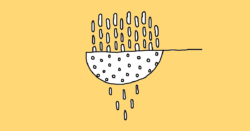
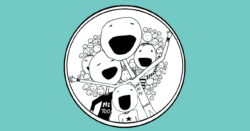


This is perfectly serendipitous! I just discovered hexagonal thinking in a random folder in my own Google Drive on Thursday, then this podcast showed up in my Apple podcasts on Friday! I’m excited to use hexagonal thinking with my 6th graders as a one-pager summative assessment and with my 7th and 8th graders in conjunction with QFT to kick off research this week. Thanks for helping me get my mind around it at just the right time.
Laura, that’s amazing! I’m so glad this podcast came to you at the right time. Your plan for using it right away sounds wonderful.
I enjoyed this podcast because it provided in depth information on how to apply the strategies in the hexagonal thinking. Critical thinking skills imperative in teaching students to think. Collaborations and discussing allows them to share their disagreements.
This is such a great idea! It requires students to dig in and think critically as well as the option to do it digitally which is exactly what I’m looking for! Thanks so much for sharing!
I’m so glad you’re excited about this, Lyns! I hope it’s a big hit with your students.
Great tool and approach.
Looking forward to trying this with my students in social studies.
Thanks for putting this together!
Hi Matt! So glad you’re excited to try hexagonal thinking – I think you and your students are going to find it a great tool. Thanks for your kind words!
I have learned something new. Its a great tool to bring students together and brainstorm new ideas.
I had never heard of this before and think it will not only be a great tool and approach, but my students will have fun using it.
Look forward to introducing it to my yearbook students.
I just love this! I can’t wait to figure out how to use this in my classroom ASAP! Is there a blog post about using the hexagonal one pagers (like the Long Way Down example) or template? I’m using sketchnotes this year and love that idea to mix things up!
Hi Betsy! I had the same reaction to this post 🙂 I would go to Betsy’s website and take a look at Hexagonal Thinking in ELA: The Ultimate Guide. Definitely download the freebie, too, if you haven’t yet! You also mention sketchnoting this year, so take a look at Using Sketchnotes and One-Pagers for Remote Learning and Sketchnotes are Awesome. I hope this helps!
this is awesome!
Thanks, Patricia! I’m so glad you’re excited about it!
This idea looks interesting for collaboration. I’m trying to think of a way to use it with lower grade levels since I teach 3rd grade. Does anyone have any ideas on a topic or concept that would work well for using this activity with younger students?
Hi Sandy,
I think this would be great with younger kids! What about doing it with ideas around building community and relationships now at the beginning of the year? You could also include some classroom norms and expectations, and think about how it all fits together? I also think it could work well for science units with the younger kids.
This is brilliant!
Do I have your permission to print this entire article and give it to each teacher at my school?
Thank you,
Elizabeth
Glad you enjoyed! And yes, you are more than welcome to share the article. Check out our FAQs to learn details. Thanks!
Hi Elizabeth,
Speaking for myself, I’d be delighted! I’m so glad you want to share it!
Take care, Betsy
This is a great tool for critical thinking, collaboration, and engagement.
Do I have permission to share this with my staff? We are fully remote for this semester and I see how this could work well in break-out rooms.
Thank you,
Julie
Yup! You are more than welcome to share the article. Check out our FAQs to learn details. Thanks!
I am wondering if the shape can be adapted? – For example “triangular” thinking so that younger students they don’t overwhelmed by the number of connections.
Love this idea! Makes me wonder how I could adapt this and build on it by using “hexaflexagons,” which I’ve used with students in past years.
I recently used hexagonal thinking within a professional development with new teachers. I used all sorts of lesson planning terms, like standards, focus skills, Kagan structure, formative assessment, summative assessment, objectives, and much more. This activity pushed my teachers to make connections with those terms but also it made them realize the most important parts of lesson planning because of how some terms would link up to others. Hexagonal thinking also provided me with an understanding of how our new teachers plan and the next steps to how I could support them in creating stronger lesson plans. Thank you for the great idea! I even had teachers that were excited to try this activity with their students. The best professional development I can give is when teachers walk away with ideas and inspiration!
This is so way cool, Kailee! Thanks so much for sharing – love it!
Great ideas for collaboration and critical thinking! Great for concrete to complex!
I really like this idea. I will be using it soon!
Learning hexagonzal is awesome, and his definitely critical thinking to expand students minds!
Just want to say I adapted this for small group work at the end of our hybrid learning year with 10th grade history students, and it was wonderful. They enjoyed it, were engaged, had good discussions, and had to use their learning in creative and meaningful ways. Thank you!
Thanks for sharing Carrie – this is awesome!
I can’t wait to try this! Great for my English classes.
Hello! Just wanted to leave a comment because I took the leap and made hexagonal thinking my final exam for my 11th grade students! We read 1984 this quarter and hexagonal thinking was a perfect assessment for such a complex novel. My students are loving the exam so far which I did not think was even possible. Their feedback has been overwhelmingly positive. I listened to this podcast recording at least 3 times before I felt I had a really good handle on how it works and the examples you provided were perfect. Thank you for this, Betsy! I appreciate the time you take to create such high quality, tangible ideas for teachers.
Thanks so much for sharing Angela! This is really fun to hear!
Love this!!!
Got great ideas fo rmy next staff meeting!
What an excellent tool to use with art history.
This seems like a great tool to use even with math. Awesome.
What a great tool to implement into the classroom to engage students in critical thinking and reading comprehension! I have been struggling with finding ways to help my students demonstrate what they are learning when they read, and coming across this tool is something that I believe will help change the game of how students can demonstrate making connections to the information they are reading. Teaching history can be boring for some students, but when strategies like this are shared, I imagine students will rise to the challenge and do great things. I can’t wait to test this out in the classroom!
So glad this post was helpful, Tyler! Once you’ve tried it out in the classroom, I hope you’ll come back and let us know how it went!
This is a great idea. I will try to use it in our Professional Learning community.
Great ideas. I teach in the primary grades so I am thinking how I might use this in a simplistic way with some of our topics we cover. Thanks
A great way to introduce the theme of the week to students in preschool.
This is a fabulous idea!! So good for math!! I never thought about it this way but everything in math builds on previous math and this type of activity would encourage discussion about what and why.
I think this is an activity that I will definitely use in my classroom.
I can definitely see how this would be a great strategy to use with math concepts. Thanks for sharing, Juliana!
I had never heard of this before and think it will not only be a great tool and approach, but my students will have fun using it, too.
Look forward to introducing it to my yearbook students.
This is an amazing learning tool. I had lots of thoughts running in my mind as I was reading it. I am sure all types of learners including adults would love and enjoy this process of Hexagon-mapping.
Do I have the permission to share this article during my workshops?
I want my students to use this strategy. I’ll be immediately implementing it. I am going to start using this strategy for unpacking the Central ideas, Book review etc. Thanks a lot fr sharing
Yes, you may share it, and we’re glad you found value in it! Please give credit to the original source when you do! Thanks.
Hexagonal thinking seems like a very innovative idea to facilitate deeper critical thinking and debate between students. Associating Key terms, figures, or events in this format is a great way to build understanding. Students arrange their hexagons in order and rationalize their movements in their own critical thinking activity. Then those same students can pair up with peers to debate and converse about the placement of each others terms. Great activity to mix up class instruction effectively!
Thank you for shring this with us. A wonderful idea for students to be creative and interactive.
Love, love , love it…..Thank you so much for sharing…..
We’re glad to hear you enjoyed the post, Tonia!
Love It!!
It is a nice approach.
Excellent resource
Can students create their own hexagons to add if they can justify?
Hi Karen,
I always include a few blank hexagons in the set when I do this activity with my students. It’s a great opportunity for them to show you their creative and original thinking!
Wow!!! What a great idea! Thinking outside of the box encourages thinking.
This is a great approach. We participated in this in a faculty meeting.
Thank you so much for sharing this strategy. I used it last year to wrap up a novel and my students enjoyed it and did an amazing job with it. I wanted to ask you, do you think it would be good to use this as a Pre-Reading activity? We are starting a new unit and was thinking this might be an engaging and interesting way to begin! Thanks
That’s an interesting idea. I’ve never tried it, but it might work. The main thing is that the activity stays true to the intent of pre-reading and that kids don’t end up making connections that lead them astray only to cause confusion when they read the text. I’m wondering if the Mind’s Eye pre-reading strategy might somehow work with the hexagonal thinking strategy. Basically, I’d give it a try; whatever lesson you do come up with, do it yourself first as if you were the student so you can make adjustments before asking students to do it. (see Dogfooding post) Let us know what you end up doing!
Great idea! I will try it in my class.
I really enjoy learning about Hexagonal Thinking. As a school psychologist I see the benefits of using the strategy in my sessions with students who have social and emotional learning concerns. I immediately thought about how to use this tool with students struggling with cognitive distortions in various areas.
Thanks for sharing this, Taneshia! So glad the post resonated with you.
I am struggling with how to use this strategy in a 7th-grade math class outside of vocabulary. Suggestions?
Nicole, I’m happy that you’re interested in using this strategy in your math class! This strategy works well with any set of interconnected concepts. For example, you might have students organize various representations of ratios (fractions, decimals, percents) and real life examples of those ratios in a hexagonal thinking template. Another idea could be to invite students to organize their approach to a complex word problem by arranging the identified components of the problem in a hexagonal thinking map. If you are on social media, I’d also recommend following the hashtag #hexagonalthinking. Lots of educators have shared some great ideas for a variety of content areas!